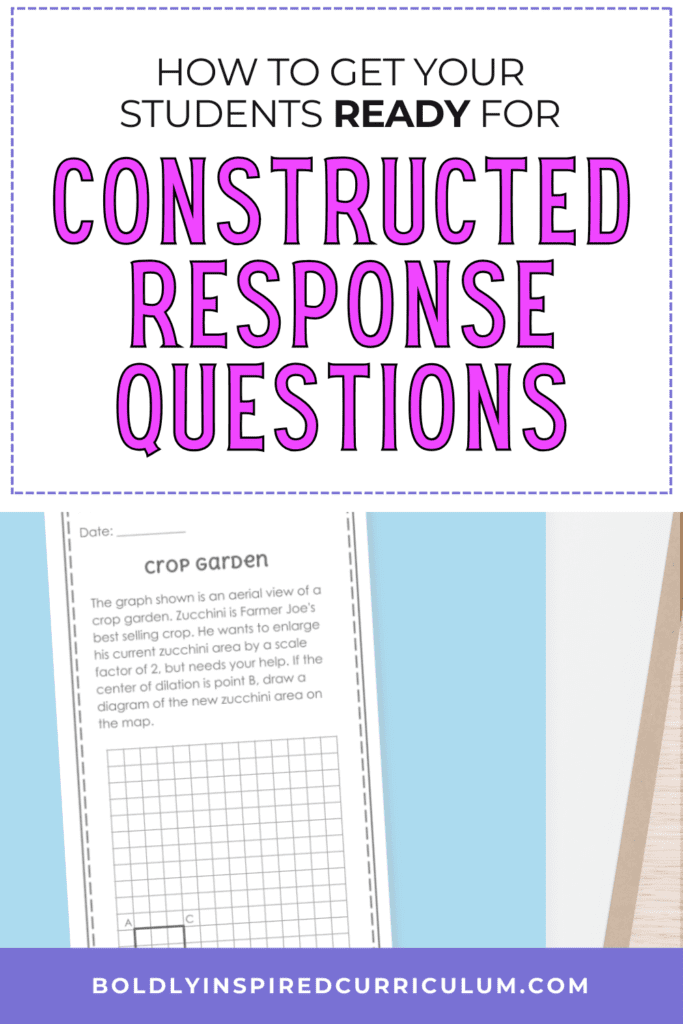Table of Contents
ToggleWhat are constructed response questions in math class?
Constructed response questions in math class are specifically found on standardized state tests. They are similar to word problems, but with an added challenge: writing. In addition to showing all of their work, students are asked to explain their thinking and show more of a justification of how they know that their answer is correct.
Most word problems require the student to analyze the problem and solve it but don’t necessarily ask them to write about it. This is the main difference between constructive response and word problems.
Constructed response questions can be very intimidating for students who don’t feel confident in their math abilities. The most challenging part of these types of questions is taking their thoughts about math and turning them into full, cohesive sentences that accurately depict their thought process.
In this blog post, I’m going to give you actionable steps to help your students build confidence for constructed response questions so that they (and you!) are ready to take on standardized testing season!

Goals for Test Prep
The goal for standardized test prep is always for students to get the best score that they can and show a reflection of their true understanding of the math curriculum.
However, in order for students to get to this point and want to show their best work, they need to feel confident in what they are doing. The more confident your students are, the better of a chance they have to succeed on their standardized testing.
Even though I am very much against interest testing, it is the reality in most school districts throughout the country and it’s something that we need to support our students with.
It’s important for students to understand why they need to take this test seriously. The best way that I have found to do this is with test prep activities and lessons that are engaging and thought provoking.
How to prepare your students for math constructed response questions
Start small
One of the easiest ways to get your students to feel comfortable with constructive response questions is to get them in the habit of writing in your math class. I like to start with really low stakes questions that could be related to the math concepts, but could also be logic puzzles or critical thinking questions.
I did an activity with my students to introduce writing by having them solve a set of complete the pattern tasks. They worked in small groups to analyze the patterns and write down their thoughts for how it could be solved.
Problems that aren’t related to math specifically feel like a lot less pressure on your students ultimately making them more engaged in the activity. It also opens up a lot of opportunities for discussion about right vs. wrong answers and problem solving strategies.
A great example for low stakes writing prompts is which doesn’t belong. There will not necessarily be a right answer to these problems. Your students can then practice explaining their thinking, defending their solutions, and engaging in whole class discussions about problem solving strategies. Which doesn’t belong prompts will also get your students thinking about different perspectives, which is a skill that will go a long way in math class and in life.
Start at the beginning of the year
If you’re anything like me you’re probably reading this blog post in March just weeks before the standardized testing. However, the best way to ensure that your students are confident in test taking and constructed response questions in general is to start practicing at the beginning of the year.
You can do this by adding writing to two to three warm-ups that you already have planned every week. By the time March rolls around, you will be shocked at the progression your students can make in articulating themselves.
Be consistent
Being consistent with not only practicing constructed response questions, but your expectations of your students’ writing will make a huge difference in the quality of work that they are turning in. Make sure that you are explaining exactly what you want your students to do when solving constructed response problems. For example, think about if you want them to just list the steps of their problem solving or if you want them to prove their answer and defend it using their work.
Student samples
Another great way to prep your students for constructed response questions specifically and set expectations for their answer is using sample responses. This could be a set of responses that are released online from your state or you could use responses from your students with blacked out names.
Using samples will not only engage your students to think about the types of questions they should expect to see on state tests, but it will also show them the expectations of answers to constructed response questions.
For example, when you give your students two sample answers, one of them shows all of the student’s work, but only a sentence about what the answer is, whereas the other response has a detailed explanation referencing the work that they showed. There is a clear difference in the quality of work for the two samples and your students will be able to see that.
So often our students get stuck because of a lack of expectations, so having samples to model exactly what you’re looking for can really support your students and help them understand the goal.
Final thoughts about constructed response questions in math
First of all, their test scores do not define who they are as learners and people, and they also don’t define you as a teacher. Second, if your students feel prepared going into the test and confident in their ability to answer any type of question that is thrown at them, there is no reason for them to be anxious.
The overall goal of test prep in this time in education is reducing test anxiety and reminding your students that there is no reason for them to feel nervous about the tests.
